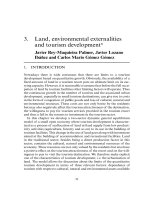THE ECONOMICS OF MONEY,BANKING, AND FINANCIAL MARKETS 475
Bạn đang xem bản rút gọn của tài liệu. Xem và tải ngay bản đầy đủ của tài liệu tại đây (41.19 KB, 1 trang )
CHAPTER 17
Tools of Monetary Policy
443
term interest rates. Why? Because the turmoil in the financial markets has
increased risk premiums, thereby keeping long-term nominal interest rates high.
Moreover, with collapsing asset prices (stock and real estate prices), there has
been an increase in deflationary expectations, which led to a rise in real interest
rates. This has the potential to make monetary policy highly contractionary,
despite falling short-term nominal interest rates.
Now that we understand how the overnight rate is determined and the Bank
of Canada s approach to monetary policy, we can examine how changes in the
three tools of monetary policy open market operations, settlement balances
management, and Bank of Canada lending affect the market for reserves and the
equilibrium overnight interest rate.
OP EN MA RKET OP E RAT I O NS
Open market operations are an important monetary policy tool for many central
banks around the world, because they are the primary determinants of changes in
interest rates and the monetary base, the main source of fluctuations in the money
supply. Open market purchases expand bank reserves and the monetary base,
thereby lowering short-term interest rates and raising the money supply. Open
market sales shrink bank reserves and the monetary base, raising short-term interest rates and lowering the money supply.
The Bank of Canada, however, stopped conducting open market operations in
Government of Canada treasury bills and bonds in 1994, and its most common
operations since then have been repurchase transactions with primary dealers
(formerly known as jobbers) the Big Six and the major investment dealers. In
particular, the Bank uses repos, which in Canada are known as special Purchase
and Resale Agreements (special PRAs or SPRAs), as a tool to reduce undesired
upward pressure on the overnight interest rate, and reverse repos, known
in Canada as Sale and Repurchase Agreements (SRAs), as a tool to reduce
undesired downward pressure on the overnight rate.
Let s see how the Bank of Canada uses special PRAs and SRAs in order to
reinforce the target for the overnight interest rate during the course of a day.
Special PRAs
Assume that the operating band for the overnight interest rate is 3.5% to 4% and
that the Bank of Canada is targeting the overnight rate at the midpoint of the band,
at 3.75%. If overnight funds are traded at a rate higher than the target rate of 3.75%,
then the Bank of Canada enters into special PRAs, typically at 11:45 at a price that
works out to a 3.75% interest rate, the midpoint of the operating band. That is, the
Bank purchases Government of Canada treasury bills or bonds, with an agreement
that the seller will repurchase them one business day later (see Figure 17-6 regarding the mechanics of a special PRA).
Since the securities are placed with the Canadian Depository for Securities
(CDS), Canada s central securities depository owned and operated by the financial
community, the title of the securities changes hands by electronic instruction. The
balance sheets of the Bank of Canada and the primary dealers look like this:
Bank of Canada
Assets
Government
securities
Primary Dealers
Liabilities
*$100
Settlement
balances
Assets
*$100
Settlement
balances
Liabilities
*$100
SPRAs
*$100









